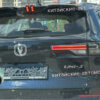Anti-collision parking sensors have become ubiquitous in vehicles of various segments, from luxury cars to budget models such as LADA. Although these electronic assistants are intended to improve safety, the reality is that there are some problems. Despite their usefulness, parking sensors can malfunction, which can lead to emergency situations.

Parking assistance systems mainly fall into two categories: electromagnetic and ultrasonic. The former, often with a limited detection range of 70-80 centimeters, struggle to match the coverage of their ultrasonic counterparts, which can detect obstacles several meters away. However, these electromagnetic sensors are often oversensitive, resulting in false alarms that can confuse drivers and cause unnecessary panic.
One of the obvious limitations of electromagnetic sensors is their reluctance to operate in a static state. To activate these sensors, drivers must start driving, which can result in a dented bumper during certain maneuvers. This inherent shortcoming highlights the need for careful use of these sensors, especially for less experienced drivers. Ultrasonic sensors, although more versatile in coverage, have their own problems. They may not notice thin or miniature obstacles, such as tree branches.

Even more worryingly, they sometimes fail to detect obstacles up to one meter high. Moreover, some barriers can reflect ultrasonic signals, catching the driver off guard with an unexpected crunching sound, especially in scenarios involving inclined surfaces or modified terrain.







